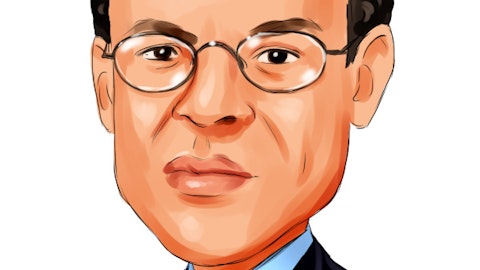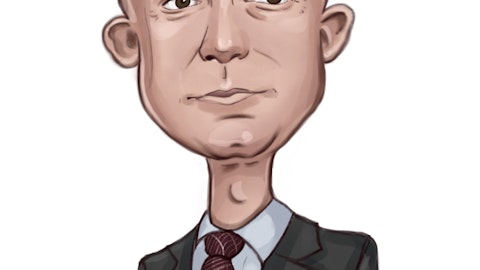In this article, we will discuss dividend stock portfolio: 5 stock picks by hedge funds. If you want to read our detailed analysis of these stocks, go directly to Dividend Stock Portfolio: 10 Stock Picks by Hedge Funds.
5. Merck & Co., Inc. (NYSE:MRK)
Number of Hedge Fund Holders: 79
Dividend Yield as of November 10: 3.14%
Merck & Co., Inc. (NYSE:MRK) is a leading pharmaceutical company operating for the last 130 years. The company’s dividend has grown at an average rate of 5.5% in the past ten years and the payout ratio stands at 45%. The company has been at the forefront in coming up with treatments for deadly diseases like Ebola and HIV.
Now Merck is leading its effort against the COVID-19 pandemic. Although the company was unsuccessful in developing a vaccine against the COVID-19 virus but is the first to come up with an antiviral known as molnupiravir to treat COVID-19.
On November 9, Merck & Co. Inc. (NYSE:MRK) announced that the US government will buy 1.4 million more doses of molnupiravir for nearly $1 billion, taking the total doses ordered to 3.1 million doses. However, the order will only be exercised if the drug receives Emergency Use Authorization (EUA) or receives complete approval from the FDA. Merck’s drug against COVID reduces the chances of hospitalization or death by 50% for patients suffering from mild to moderate COVID-19.
Artisan Partners shared its insights on Merck & Co. Inc. (NYSE:MRK) in its Q2 2021 investor letter. Here’s what the fund had to say:
“In Q1, we initiated a position in Merck, a provider of health care solutions including prescription medicines, vaccines, biologic therapies, animal health and consumer care products. We purchased Merck when the stock came under pressure in part on concerns that the newly minted Biden administration could implement regulatory changes and lower drug costs in the pharmaceutical industry. Recent, but anticipated changes to Merck’s management team have also weighed on shares, as have concerns over the company’s heavy reliance on immunotherapy treatment Keytruda. Notably, Merck is not getting much credit from investors for the 60+ programs it has in clinical development, despite having several solid and large new product opportunities. Additionally, the company’s strong balance sheet and robust free cash flow provide it multiple options for future partnerships and acquisitions. While Merck is undergoing a period of transition, we think the company’s fundamentals are strong and believe changes to management should be a catalyst for improvement.”
Merck & Co. Inc. (NYSE:MRK) has also reached an agreement with the Japanese government to supply 1.6 million doses of molnupiravir for $1.2 billion. However, the deal is also dependent on approval from Japan’s Pharmaceuticals and Medical Devices Agency. It would be interesting to note that the UK’s Medicine and Healthcare Regulatory Agency has given the approval to molnupiravir to be used as the first antiviral for the treatment of COVID-19.
4. AbbVie Inc. (NYSE:ABBV)
Number of Hedge Fund Holders: 82
Dividend Yield as of November 10: 4.88%
AbbVie Inc. (NYSE:ABBV) is a research-based global pharmaceutical company that was split from Abbot Laboratories (NYSE:ABT) in January 2013 and now has become bigger than its parent. Since the spin-off, AbbVie has continued the trend of increasing its annual dividend like Abbott Laboratories has done and is also a part of the Dividend Aristocrat List for increasing its annual dividend for the past 49 consecutive years.
AbbVie Inc. (NYSE:ABBV) offers a dividend yield that is more than three times higher than the average of the S&P 500 stocks. In the last three years, dividends have increased by 13% and the payout ratio stands at 41%. The company is behind popular drugs like Humira, Skyrizi, and Rinyoq.
In a research note issued on November 1, David Risinger, an analyst at Morgan Stanley increased the price target on AbbVie Inc. (NYSE:ABBV) from $116 to $124 and maintained an Overweight rating on the stock following a “solid quarter,” on the back of strong performance of the aesthetics division.
Of the 873 hedge funds tracked by Insider Monkey, 82 held a stake in AbbVie Inc. (NYSE:ABBV) at the end of Q2 2021 in comparison to 72 hedge funds in the previous quarter. This reflects the peaking interest of hedge funds in the healthcare company.
3. Citigroup Inc. (NYSE:C)
Number of Hedge Fund Holders: 87
Dividend Yield as of November 10: 3%
Citigroup Inc. (NYSE:C) is one of the leading names in the financial sector offering investment banking and financial services. The company is increasing its focus on the six metropolitan cities in the US, despite pursuing a digital-first mindset. The bank believes that customers still value the branch for high-value transactions like mortgages or loans for a small business. On the other hand, the company wound up its consumer banking arm in South Korea and booked a $1.5 billion charge on its financial statements. The bank trades at a relative discount against its industry peers due to its weaker retail consumer division but the management is now focused on exiting non-profitable markets and refocusing the investment towards businesses that earn higher returns.
Citigroup Inc. (NYSE:C) has been increasing its dividend since Q3 2019. The company’s dividend payout ratio is 21%. Analysts see a possibility of an increase in dividend along with a special one-time dividend that can be paid out by the company in the coming quarters.
In mid-October, James Fotheringham at BMO Capital increased the price target on Citigroup Inc. (NYSE:C) by $2 to $86. This reflects a potential upside of more than 25% from the current stock price. Fotheringham termed Citi as “the top pick by far” amongst the banks due to its valuation. The analyst anticipates the company to report a higher Return on Average Tangible Common Shareholder’s Equity (RoTCE) in March.
2. Johnson & Johnson (NYSE:JNJ)
Number of Hedge Fund Holders: 88
Dividend Yield as of November 10: 2.61%
Johnson & Johnson (NYSE:JNJ) is one of the world’s largest healthcare companies that has been operating for 130 years with 130,000 employees currently working across the globe. For dividend investors, it would be interesting to know that the New Jersey-based company is part of the 2021 Dividend Aristocrats list. This is a list of 65 companies that have been increasing their dividend payout annually for at least the past 25 consecutive years. Johnson & Johnson (NYSE:JNJ) has been increasing its dividend for the past 59 consecutive years.
The company is at the forefront in response to the COVID-19 pandemic. On November 10, the company entered into an agreement with the US government and the Vaccine Alliance, Gavi to provide its single-shot vaccine to the most vulnerable people worldwide through the COVAX Humanitarian Buffer. In addition to this, the company received approval for its booster shots by the US Food and Drug Authority (FDA) on October 20.
Johnson & Johnson (NYSE:JNJ) was mentioned in the Q2 2021 investor letter of Distillate Capital. Here’s what the investment management firm said:
“The largest additions in the rebalance, Johnson & Johnson was around 50 and 40 basis points incrementally. J&J underperformed in the quarter while its normalized free cash flows held steady and so its position size was topped off to match the stable cash flows.”
Johnson & Johnson (NYSE:JNJ) can be considered as a defensive stock with a global footprint and growing dividends. The company’s gross profit margin has been above 70% for the past four years and the operating earnings have grown for the past 35 consecutive years. Furthermore, the company has invested $50 billion since 2017 to acquire other companies for top-line and bottom-line growth.
1. JPMorgan Chase & Co. (NYSE:JPM)
Number of Hedge Fund Holders: 108
Dividend Yield as of November 10: 2.38%
JPMorgan Chase & Co. (NYSE:JPM) is an investment bank and financial services firm that provides its services to leading organizations, institutions, and governments globally. The company divides its business into four notable segments. The Consumer and Community Banking segment is for the daily banking needs of the masses. The Corporate and Investment Bank segment caters to the needs of corporations. The Commercial bank segment is into providing payment services. Meanwhile, the Asset and Wealth Management segment invests in various asset classes on behalf of its clients.
Having numerous proven businesses under the same umbrella has resulted in strong cash flows and shareholder returns in the form of dividends. The company’s dividend yield of 2.38% is significantly higher than the S&P 500’s current dividend yield of 1.3%. The interest rates have been depressed since the start of the COVID-19 pandemic to encourage economic activity and companies like JP Morgan Chase are an alternative for lost income that could have been generated by investing in high-yield bonds.
Vltava Fund discussed its stance on JP Morgan Chase & Co. (NYSE:JPM) in its Q3 2021 investor letter. Here’s what the fund said:
“While all the previous names could be categorised as founder, continuing, or key shareholders, these last two names fall into the category of hired professional managers. This is actually the most numerous category among the bosses of large companies, but even among them there exist a number of individuals with exceptional long-term track records. In our view, these include also Jamie Dimon and Herman Gref.
We consider JP Morgan to be the strongest, largest, and most profitable bank in the world. It has not always been so, and the fact that it is what it is today can be attributed especially to its CEO Jamie Dimon. Dimon has spent his entire career in banking. He came to JP Morgan in a roundabout way in 2004 after the bank bought Bank One, of which he was CEO at the time. Since early 2006, Dimon has been CEO of the entire JP Morgan.
The quality and strength of JP Morgan under his leadership became fully apparent for the first time in 2008. Not only did JP Morgan help to stabilise the market by taking over the failing Bear Stearns in the spring of that year, but it was the only major US bank that did not require government assistance throughout the Great Financial Crisis and that was highly profitable even in the difficult year of 2008. Today, JP Morgan is even bigger, even more profitable, and even stronger than ever before. Many investors view banks with disdain, but a good bank with good management can be a very good long-term investment. From the time of its merger with Bank One in 2004 through the end of 2020, JP Morgan’s stock has outperformed even the S&P 500 index. The bank has earned a total net profit of USD 330 billion during this period, of which USD 232 billion has been paid out to shareholders in dividends and in share buybacks. I can recommend two books about Jamie Dimon: The House of Dimon and Last Man Standing.”
JP Morgan Chase & Co. (NYSE:JPM) reported its Q3 2021 earnings on October 13 and continued its trend of outperforming consensus estimates for the past five consecutive quarters. On October 25, Mike Mayo at Wells Fargo increased the price target on JP Morgan Chase & Co. (NYSE:JPM) from $200 to $210 and maintained an Overweight rating on the stock. The analyst highlighted his confidence in the earnings capacity of the company.
You can also take a peek at the Jeff Bezos Stock Portfolio: 5 Companies Bezos Is Investing In and 9 Best Hydrogen Fuel Cell Stocks To Buy.





